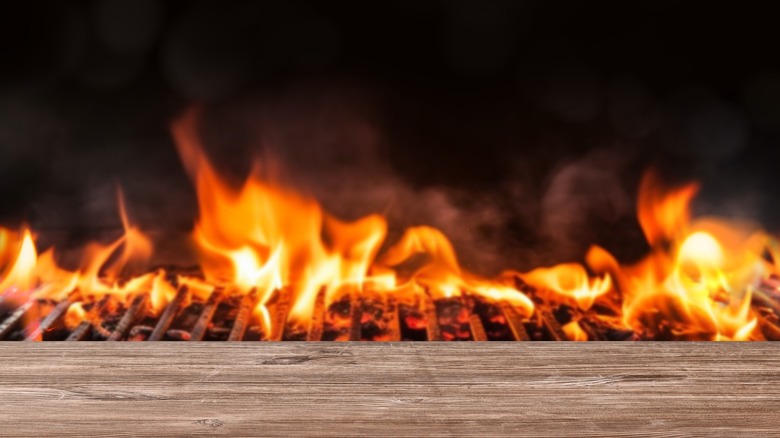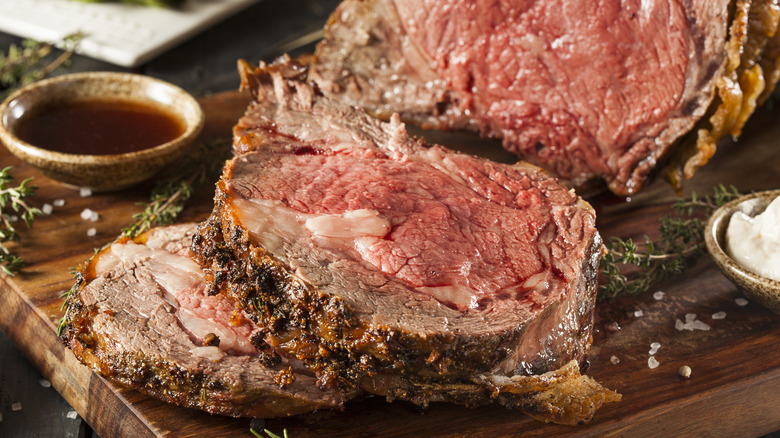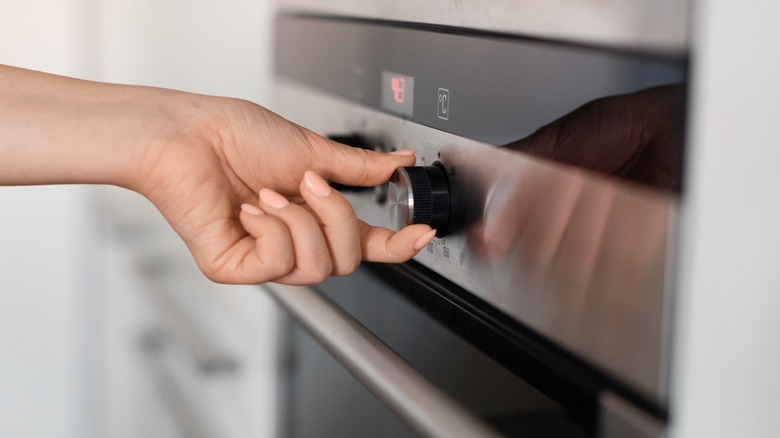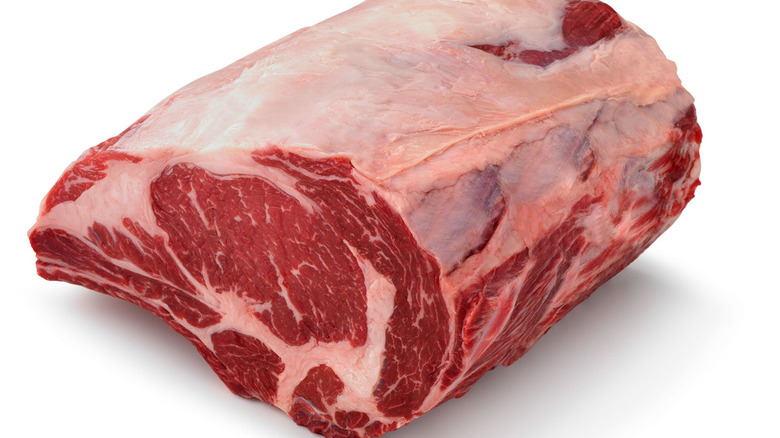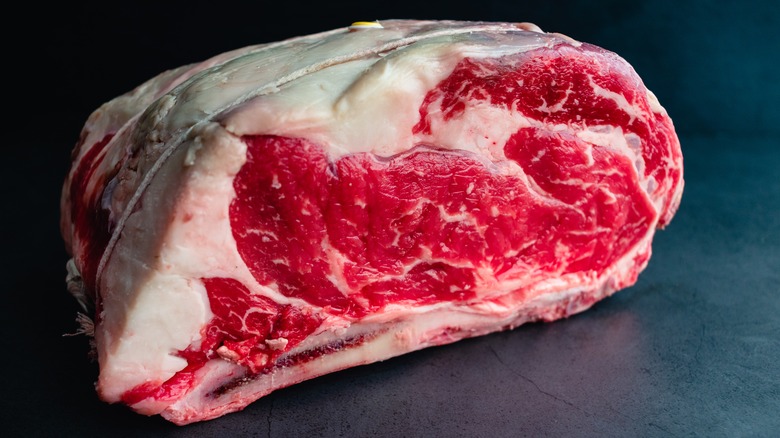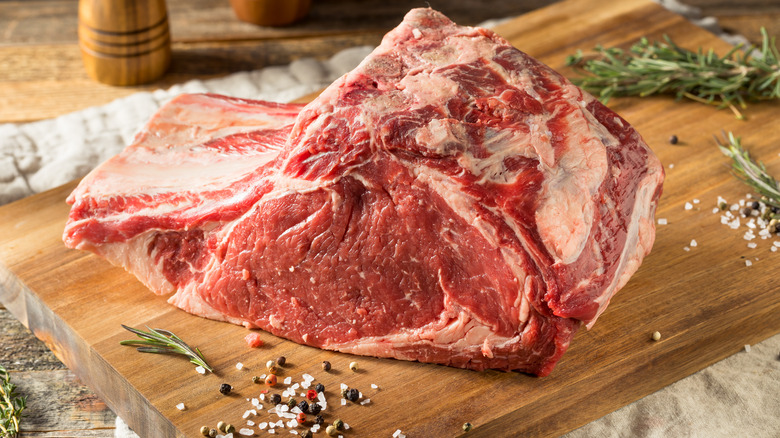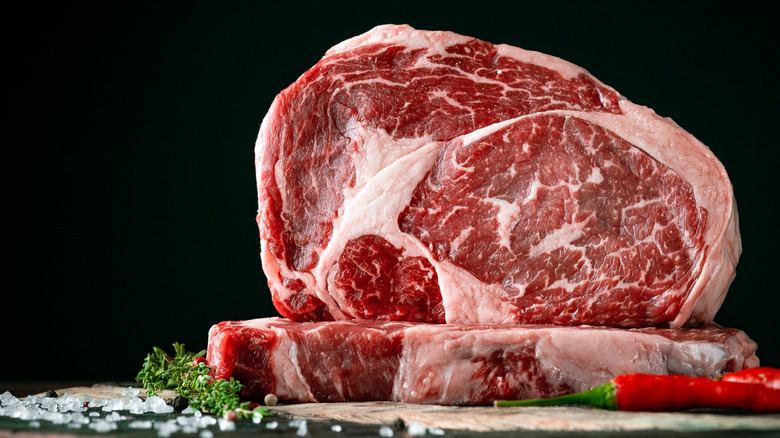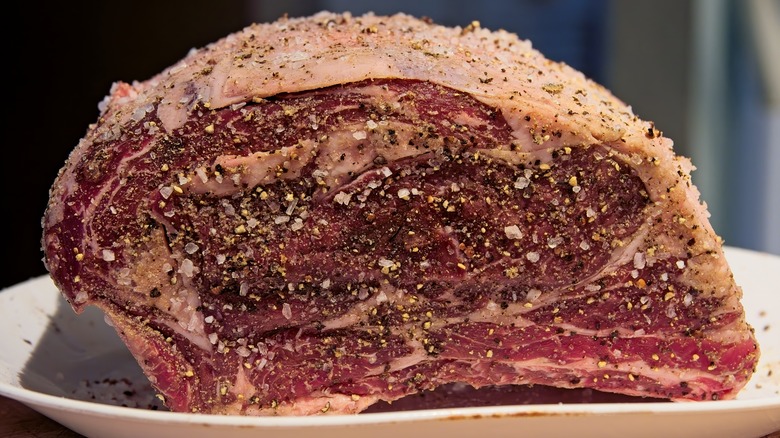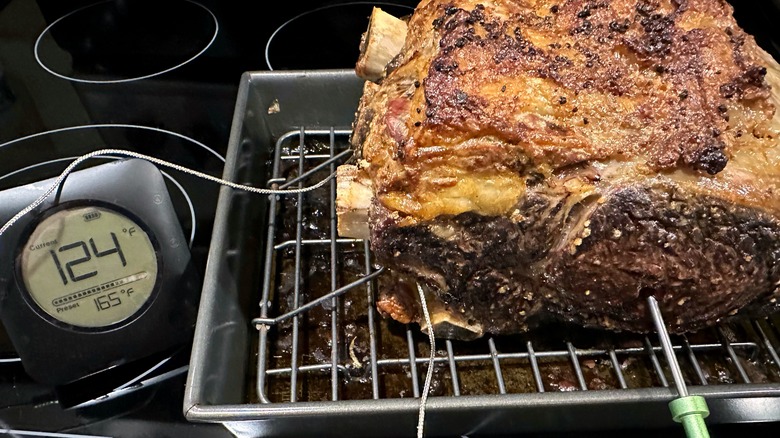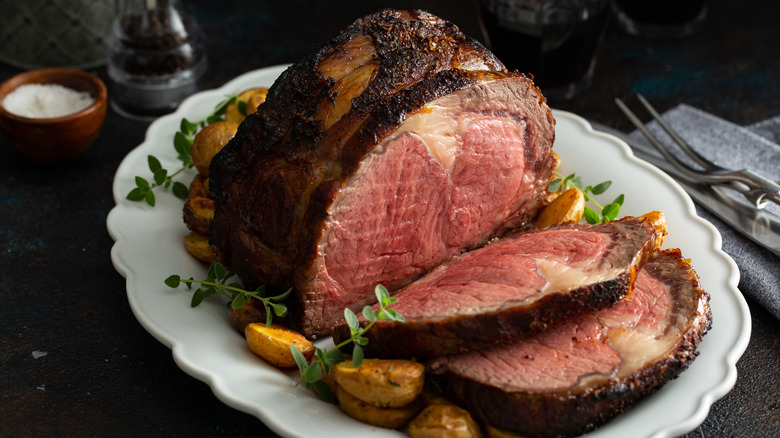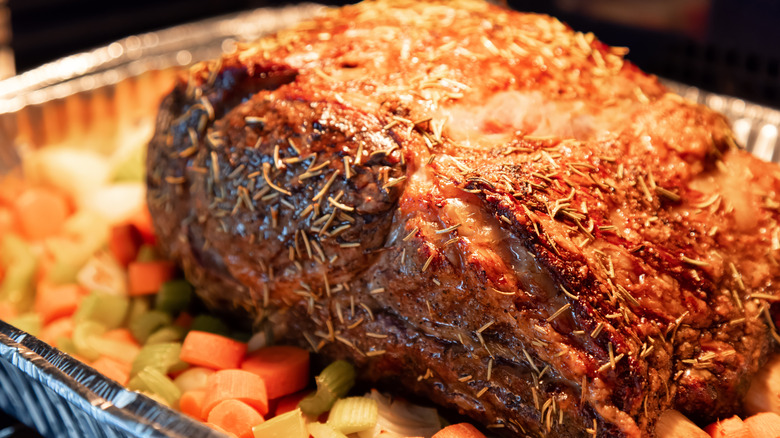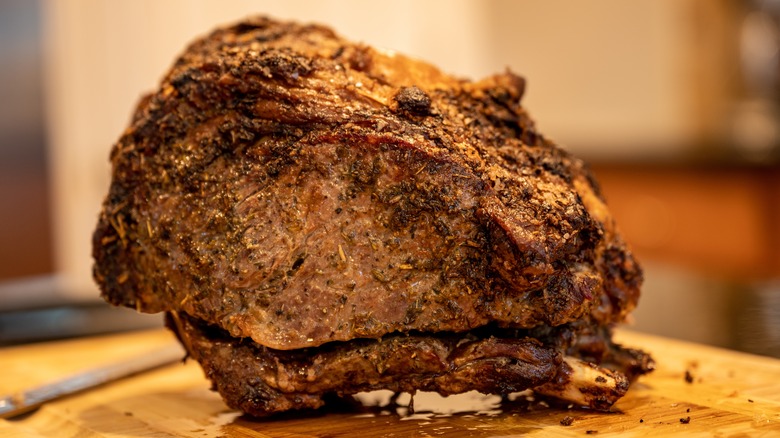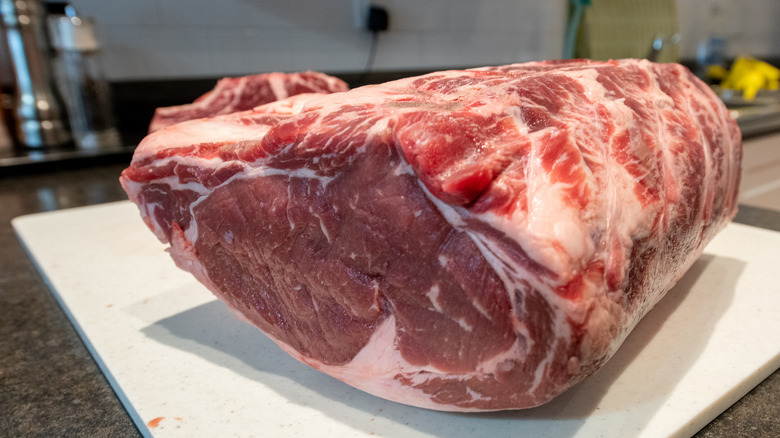Award-Winning Chef Jean-Pierre's 13 Mistakes To Avoid When Cooking Prime Rib
Nothing strikes fear in the heart of the home cook more than messing up an expensive cut of meat. Whether it's a porterhouse steak or prime rib roast, no one wants to see a good piece of meat become something not even the dog will touch. From choosing the best cut at the butcher counter to cooking the meat to the right internal temperature, there are a number of steps from beginning to end where something could potentially go wrong.
Prime rib frequently graces the center of the dinner table. The first mistake you want to avoid before serving this up to your family and friends is choosing the wrong cut of meat. It can get confusing when talking about prime rib, and the confusion lies in the name. Prime is not an indicator of location on the cow; it simply means a higher grade of beef. Unfortunately, this higher grade of beef is difficult to find and tends to be pricier. Your butcher or local food store is more apt to offer choice grade standing rib roast.
We spoke with award-winning professional chef, teacher, and television star, Chef Jean-Pierre, to discuss important steps when cooking prime rib. Beginning his chef journey working in a butcher shop, he has dedicated his life to food, authored cookbooks, and taught millions of social media followers how to cook. Learn mistakes to avoid so you, too, can cook prime rib like a chef and impress your friends and family at your next gathering.
1. Searing prime rib at the start of cooking
One of the most common mistakes when cooking prime rib is searing the roast at the start of cooking. Though this method is frequently used to cook various cuts of steak, lamb, or pork with good results, the ideal way to cook prime rib is with a reverse sear. Why is this? Chef Jean-Pierre tells us cooking prime rib at a high temperature from the start creates overcooked meat with a gray outer crust. That doesn't sound very appetizing to us.
What does it mean to reverse sear? This cooking technique is not as complicated as it sounds. Searing meat requires high temperature for a short amount of time to quickly and effectively crisp up the outer surface, which refers to the Maillard reaction — the chemical process that happens when food cooks with high heat, by roasting, grilling, or frying. This action creates the desired umami bite that makes your mouth water as soon as meat hits your tongue. Reverse sear simply means sparking the Maillard reaction at the end of fully cooking the meat, rather than at the beginning.
Prime rib benefits most from reverse sear because the roast will cook evenly at low temperature first without damaging the muscle fibers, which can generate a tough chew or the ugly gray color no one wants to see. Reverse sear also gives your roast a better crust; one that is not just tasty but aesthetically pleasing, as well.
2. Not roasting to maximize the beefy flavor
Prime rib is typically slow roasted in an oven, though there are other ways you can enjoy the cut, such as smoked or grilled. And that could be considered another mistake you want to avoid: not trying an alternate cooking method. But there's a reason why oven roasting is one of the best ways to cook this popular cut of beef. "I find that roasting usually has a crispier outer crust," Chef Jean-Pierre says. "While both oven-roasted and smoked prime rib can be delicious, the smoked version tends to have a more pronounced smoky flavor and aroma, while the oven-roasted version focuses more on the natural flavors of the beef."
Prime rib is pretty prime in flavor. One of the top cuts for tenderness and taste, prime rib roast has its own savory profile. Oven roasting enhances its natural beefiness while smoking or grilling lends other types of flavors from either charcoal or smoke. Grilled or smoked prime rib is certainly worthy of starring at your next barbecue, though. Explore the best types of wood for smoking and grilling and elevate your next prime rib to multiple levels.
3. Cooking prime rib with high temperature
Just as you don't want to begin cooking a prime rib roast at a high temperature (remember, you want to reverse sear), you want to avoid cooking with high temperature for the entire length of cooking time. Prolonged high temperature can destroy muscle fibers, resulting in a tough, leather-like chew and making it look like you've incinerated your prime cut of beef.
Slow roasting prime rib cooks the meat more evenly and allows muscle fibers and collagen time to break down gently, so your end result is tender, juicy rib meat, rather than dense, dry jerky. And the only way to slow roast something is with low temperature over a long duration. That's why prime rib is usually roasted or smoked, often for hours. When you cut prime rib into ribeye steaks, you can take advantage of cooking at a higher temperature, like with pan-searing or on the grill. You don't have as much meat to cook, so you can afford to turn up the flame and enjoy rib meat in a different but equally satiating way.
4. Selecting the leaner end of prime rib
The entire rib section of the cow is considered prime rib roast but can constitute nearly 25 pounds of meat. Because not many folks want to buy a 25-pound rib roast, it's often cut in two. Which is why not all prime rib is created equal — it can depend on the end it's cut from. A cow's ribs are numbered 6 through 12. Ribs numbered 6 through 9 are near the chuck end, feature more marbling, and are, therefore, fattier. Ribs 10 through 12 are closer to the loin end and are leaner. Those who want a fattier, tender, more flavorful roast should opt for the chuck end when buying prime rib.
Technically, prime rib from either end is a delicious option, but it could be a mistake if you don't even try to ask your butcher for prime rib from the chuck end. After all, as Chef Jean-Pierre tells us, "It is more tender, much more flavorful." And if you're going to go through the entire process of selecting, prepping, and cooking prime rib the best way you can, it all starts at the butcher counter.
5. Choosing the incorrect weight
As we've discussed, when a butcher breaks down prime rib from one side of a cow, it's cut in its entirety, in sections, or even as individual ribeye steaks. Choosing the right weight for your culinary needs is an important part to creating a prized prime rib. If you're feeding a large crowd, you might want to consider purchasing the entire rib section; but if you're entertaining a smaller crowd, a 12- to 15-pound prime rib will suffice. Most of the time, you'll see prime rib sold somewhere between 5 and 8 pounds. How many people does this feed, and what is the ideal serving size? A general rule is 1 pound of meat per person, with one bone-in rib for every two people.
Chef Jean-Pierre recommends looking for prime rib featuring three bones, which should serve roughly six people. Occasionally, you'll see prime rib offered as a rolled roast or boneless. But when it comes to roasting prime rib and getting the most out of it, you want the bone-in option. Besides, it's not called standing rib roast for nothing — you can actually stand the roast up on the bones while it cooks.
6. Not dry brining prime rib for 24 hours
Salt is not just for adding flavor to foods. It performs multiple duties from brining to finishing. Brining is the act of soaking meat in saltwater for an extended period of time to enhance flavor, boost tenderness, and help retain moisture, while dry brining refers to salting meat without using liquid.
According to Chef Jean-Pierre, one of the most common mistakes home cooks make and should avoid when cooking prime rib is also a must-do preparation step: dry brine the roast 24 hours before you plan on popping it in the oven. Anything less won't give you the most optimal results. Chef Jean-Pierre further explains to us, "One hour before does not do anything but create a moist outside since the salt draws moisture, and you are not giving it enough time to penetrate back inside the meat."
Dry brining is one of the easiest ways to create a more flavorful and tender cut of meat — you're just salting meat liberally and leaving it in the fridge overnight to hang out. The longer the brine, the longer the salt has to penetrate the meat and dry out the surface. But that doesn't mean you can't dry brine for a shorter amount of time, if needed. In his "How to Cook a Perfect Prime Rib" YouTube video, Chef Jean-Pierre suggests salting at least a few hours before cooking, if the full 24 hours is not possible. Because you should always salt your prime rib before cooking.
7. Under-salting your roast during preparation
Not only is the duration of your brine important, but so is the amount of salt you use (and its size). Too little salt, and not only will it not seep deep into the roast, but it also won't dry the surface for an effective Maillard reaction when reverse searing. It also matters whether you use fine or coarse salt, though, to determine how much to use. How do you know the best type of salt to use for dry brining?
According to Chef Jean-Pierre, the answer is fine Kosher salt. The finer grain of salt soaks the meat more easily than a coarse salt, which is more often used as a finishing salt. Since salt also adds flavor to your roast while it works its briny magic, the brand of salt you use could matter to your taste buds. Different types of salts may give you different end results. The amount of salt you brine prime rib with depends on the size of the roast you selected. But it's also debatable — anywhere from a half teaspoon to a teaspoon and a half of salt per pound of meat. So if you're worried about too much salt, start with the smaller amount.
8. Over-salting prime rib during preparation
Salt is clearly an important component to cooking the best prime rib of your life. But along with not wanting to under-salt meat when brining, you don't want to over-salt meat either. Too much salt in your dry brine, and your end result could be too salty to eat. And no one wants to ruin a big roast. We checked with Chef Jean-Pierre about whether or not over-salting can be corrected, and unfortunately, there is no solid way to fix an over-salted cut of meat. So how much is too much?
Personal preference takes a role in salt preparation. As we've stated, the recommended amount varies so that what one might not consider too salty is definitely too salty for another. If this is your first time salting meat, consult a recipe or err on the side of caution and go light on the salt. But if you find you and your roast on the side of too salty, you might want to consider adding a sauce or side dish that directly complements the incredible saltiness. Think spicy, tangy, or sweet.
9. Not using a thermometer to determine desired doneness
The importance of a proper thermometer for cooking meat cannot be understated. Sure, you can play a guessing game of "When will it be done?" — but you may wind up with shoe leather or a rubber biscuit instead of a succulent piece of meat. You could also follow a recipe to the letter since timing can be a decent gauge, but ovens can vary with internal temperature, and you can't forget to factor in altitude. The best way to ensure proper doneness of meat is to use a meat thermometer. As Chef Jean-Pierre says, "[It's] difficult to do without!"
Why is it difficult? At some point in the process of roasting prime rib, it needs to rest undisturbed. You need a meat thermometer to check the internal temperature of the roast to determine if it has actually reached the temperature you're looking for. If it's under, you'll know right away and can keep cooking it; but if you wait until it's on the table and ready to be served, you could be really disappointed. And you never want to cut into a roast before it's had a chance to rest.
10. Overcooking your roast
Prime rib is best when cooked medium rare. One of the biggest mistakes anyone can make when cooking prime rib is to overcook it. While there lies a range of red and pink, from rare to medium where you can call it good, there's a point of no return when the meat resembles shreds of bark. This is where a meat thermometer comes in handy; it keeps you on track to getting the roast out of the oven at the right time, which is when it's medium rare.
A meat thermometer is going to tell you the internal temperature of your roast, and thus, whether you've reached desired doneness or not. The ideal internal roasting temperature for medium rare prime rib is 120 to 135 F. Anything lower than 120 F, and it's considered rare. If you take the temperature of your meat before resting, remember the internal temperature will rise about 5 degrees. Factor this time into how cooked you want your prime rib roast.
11. Cooking prime rib covered
Maybe it's the vision of mom or grandma in the kitchen leaning over a large pot with a large roast, spoon in one hand and cover in the other, that makes us think we need to roast meat covered. You don't. As a matter of fact, Chef Jean-Pierre says to definitely keep prime rib uncovered during cooking. It may sound opposite to want your meat to dry out, but in this case, you do want the outer surface of your roast to dry out further. That way, when you reverse sear, you get a super crispy, melt-in-your-mouth bite.
One reason you brined the roast was to help it retain moisture, so when you cook it, the end result is still juicy and tender. You don't need to cover prime rib for this to happen. If you choose to cover the roast while it's cooking, it may remain too moist and could miss out on a sizzling, crunchy exterior from the reverse sear. If you're afraid of the prime rib drying out while cooking uncovered, the roast will have a chance to hold onto moisture during rest time.
12. Not covering your roast during rest time
Let meat rest after cooking, even after cooking slow in low temperature. Once the heat is off, your roast gets the chance to redistribute moisture back evenly throughout the muscle as it relaxes, or rests. Now's the time you want to cover your roast so it doesn't dry out from the air and so it can effectively finish cooking. You don't want to leave it in your oven because it will take time for your oven to cool down, and it could overcook your roast.
Prime rib should be covered during the resting phase so the meat retains its heat, finishes cooking, and remains tender and juicy before the reverse sear. The steam from the cooked roast will help add some moisture back to the surface, but not enough to ruin your reverse sear. If you sear the roast first and then cook and rest it, the steam could actually create a soggier crust than you had intended.
13. Bringing prime rib up to room temperature before cooking
Anyone who has ever stepped foot in the kitchen to cook dinner or lit the grill to start the barbecue has probably heard how bringing a cut of meat to room temperature before cooking is the ideal way to achieve the best result. The thought behind this action is that colder meat can take longer to cook, and if you're working with a recipe, the timing may be off. Also, cold meat still has moisture on the surface, and it won't brown properly in the pan or oven.
However, this is mostly myth, and it can take hours for the internal meat of a large roast to even come close to room temperature. Though you may have hours at your disposal, you're crossing into dangerous territory with surface bacteria on your premium cut of beef. Letting meat reach room temperature is best left to small, individual cuts of steak.
But since there is constant back and forth debate about this old practice, let's turn back to Chef Jean-Pierre on this matter. "No need to leave it outside the fridge before cooking," he tells us. "I tried several times, and besides experiencing no substantial change on the inside temp, it does not do anything for the cooking."

